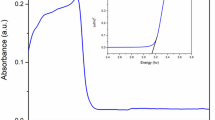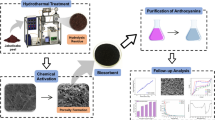Abstract
Humic-like substances are essential components of soluble organic matter in tannery wastewater. However, the tannery process can promote the abiotic humification in wastewater. Therefore, it is of great significance to clarify the pathway and degree of abiotic humification and the properties of the as-derived humic acid-like (HAL) complex polymers in the tannery process in order to control the refractory organic compounds. In the present study, considering the catechol-Maillard system and commercial humic acid (HA) as control, the polyphenol-Maillard humification in the tannery process was simulated under the catalysis of MnO2. Moreover, physicochemical and spectroscopic techniques were used to characterize the separated fractions of HAL further. As a result, it was found that the catechol-Maillard system with small molecule organic matter as precursor had higher humification degree. Furthermore, the ultraviolet-visible (UV-Vis), Fourier transform infrared (FTIR), and excitation-emission matrix (EEM) fluorescence spectrum of humic acid-like 0 (HAL0) derived from it was different from those of humic acid-like 1 and 2 (HAL1 and HAL2) of polyphenol-Maillard system, indicating the differences of polymer structure between them. In the polyphenol-Maillard system, tannin was the skeleton of polymerization or polycondensation reaction, and the high content of N and the H/C value of HAL2 indicated that in adding to amino acids, proteins promoted the humification, forming industry-specific HAL polymers with a high degree of aliphatic nature. Therefore, it can be concluded that controlling the raw materials in the tannery process (especially tannins), in order to reduce the occurrence of abiotic humification may be the key to improve the efficiency of wastewater treatment.



Similar content being viewed by others
References
Abdulla HM, El-Shatoury SA, El-Shahawy AA, Ghorab SA, Nasr M, Trujillo ME (2019) An integrated bioaugmentation/electrocoagulation concept for olive mill wastewater management and the reuse in irrigation of biofuel plants: a pilot study. Environ Sci Pollut Res 26:15803–15815
Amir S, Benlboukht F, Cancian N, Winterton P, Mohamed H (2008) Physico-chemical analysis of tannery solid waste and structural characterization of its isolated humic acids after composting. J Hazard Mater 160(2–3):448–455
Barber LB, Leenheer JA, Noyes TI, Stiles EA (2001) Nature and transformation of dissolved organic matter in treatment wetlands. Environ Sci Technol 35(24):4805–4816
Belcarz A, Ginalska G, Kornillowicz-Kowalska T (2005) Extracellular enzyme activities of Bjerkandera adusta R59 soil strain, capable of daunomycin and humic acids degradation. Appl Microbiol Biotechnol 68(5):686–694
Benlboukht F, El Fels L, Bouamri R, Amir S, Hafidi M (2016) Assessment of fulvic acid-like fractions during tannery waste composting. Compost Sci Util 24(3):208–218
Chai XL, Takayuki S, Cao XY, Guo Q, Zhang YC (2007) Spectroscopic studies of the progress of humification processes in humic substances extracted from refuse in a landfill. Chemosphere 69(9):1446–1453
Coble PG (1996) Characterization of marine and terrestrial DOM in seawater using excitation-emission matrix spectroscopy. Mar Chem 51(4):325–346
Colak SM, Oezguenay H, Mutlu MM, Akyuez F (2005) Reducing the amount of tanning materials passing into wastewater in post-tanning processes. J Am Leather Chem As 100(3):111–118
Collado S, Oulego P, Suarez-Iglesias O, Mario D (2018) Biodegradation of dissolved humic substances by fungi. Appl Microbiol Biot 102(8):3497–3511
Dixit S, Yadav A, Dwivedi PD, Das M (2015) Toxic hazards of leather industry and technologies to combat threat: a review. J Clean Prod 87(15):39–49
Domeizel M, Khalil A, Prudent P (2004) UV spectroscopy: a tool for monitoring humification and for proposing an index of the maturity of compost. Bioresour Technol 94(2):177–184
Enev V, Pospisilova L, Klucakov M, Liptaj T, Doskocil L (2014) Spectral characterization of selected natural humic substances. Soil Water Res 9(1):9–17
Fan CH, Zhang YC, Tang ZH, Wang JH (2015a) FTIR and 13C NMR analysis of dissolved organic matter (DOM) in the treatment process of tannery wastewater. Spectrosc Spect Anal 35(5):1203–1207
Fan CH, Zhang YC, Du B, Song J, Huai CQ, Wang JH (2015b) Spectral analysis of dissolved organic matter of tannery wastewater in the treatment process. Spectrosc Spect Anal 35(6):587–1591
Frølund B, Palmgren R, Keiding K, Nielsen PH (1996) Extraction of extracellular polymers from activated sludge using a cation exchange resin. Water Res 30(8):1749–1758
Hajjouji HE, Fakharedine N, Baddi GA, Winterton P, Bailly JR, Revel JC (2007) Treatment of olive mill waste-water by aerobic biodegradation: an analytical study using gel permeation chromatography, ultraviolet–visible and Fourier transform infrared spectroscopy. Bioresour Technol 98(18):3513–3520
Halim M, Spaccini R, Parlanti E, Amezghal A, Piccolo A (2013) Differences in fluorescence properties between humic acid and its size fractions separated by preparative HPSEC. J Geochem Explor 129(6):23–27
Hardie AG (2008) Pathways of abiotic humification as catalyzed by mineral colloids. Dissertation, University of Saskatchewan
Hättenschwile S, Hagerman A, Vitousek P (2003) Polyphenols in litter from tropical montane forests across a wide range in soil fertility. Biogeochemistry 64(1):129–148
Hu YT, Wang XP (2017) Application of surrogate parameters in characteristic UV-vis absorption bands for rapid analysis of water contaminants. Sensor Actuat B-chem 239:718–726
Imai A, Fukushima T, Matsushige K, Kim YH, Choi K (2002) Characterization of dissolved organic matter in effluents from wastewater treatment plants. Water Res 36(4):859–870
Jokic A, Zimpe Z, Huang PM, Mezey PG (2001) Molecular shape analysis of a Maillard reaction intermediate. SAR QSAR Environ Res 12(3):297–307
Jokic A, Wang MC, Liu C, Frenkel AL, Huang PM (2004) Integration of the polyphenol and maillard reactions into a unified abiotic pathway for humification in nature: the role of δ-MnO2. Org Geochem 35(6):747–762
Kanth SV, Venba R, Madhan B, Chandrababu NK, Sadulla S (2009) Cleaner tanning practices for tannery pollution abatement: role of enzymes in eco-friendly vegetable tanning. J Clean Prod 17(5):507–515
Khemakhem M, Papadimitriou V, Sotiroudis G, Zoumpoulakis P, Arbez-Gindre C, Bouzouita N (2016) Melanin and humic acid-like polymer complex from olive mill waste waters. Part I. isolation and characterization. Food Chem 203(15):540–547
Lähdesmäki P, Piispanen R (1988) Degradation products and the hydrolytic enzyme activities in the soil humification processes. Soil Biol Biochem 20(3):287–292
Li LB, Yan S, Han CB, Shan GB (2005) Comprehensive characterization of oil refinery effluent-derived humic substances using various spectroscopic approaches. Chemosphere 60(4):467–476
Li XW, Xing MY, Yang J, Zhao LM, Dai XH (2013) Organic matter humification in vermifiltration process for domestic sewage sludge treatment by excitation–emission matrix fluorescence and fourier transform infrared spectroscopy. J Hazard Mater 261:491–499
Li SY, Li DY, Li JJ, Zhang GX, Zhang BX (2017) Evaluation of humic substances during co-composting of sewage sludge and corn stalk under different aeration rates. Bioresour Technol 245:1299–1302
Li TT, Song FH, Zhang J, Liu SS, Xing BS, Bai YC (2020) Pyrolysis characteristics of soil humic substances using TG-FTIR-MS combined with kinetic models. Sci Total Environ 698:134237
Lina F, Maria A (2018) Vegetable tannins used in the manufacture of historic leathers. Molecules 23(5):1081
Lipczynska-Kochany E (2018) Humic substances, their microbial interactions and effects on biological transformations of organic pollutants in water and soil: a review. Chemosphere 202:420–437
Liu Q, Zhuang LY, Ni XY, You CM (2018) Nitrogen additions stimulate litter humification in a subtropical forest, southwestern China. Sci Rep 8(1):17525
Ma HR, Gao M, Hua L, Chao H, Xu J (2015) The stabilization of tannery sludge and the character of humic acid-like during low temperature pyrolysis. Environ Sci Pollut R 22(21):16791–16802
Madhan B, Sreeram KJ, Sharli A, Rao JR (2005) An integrated approach for the treatment of vegetable tanning wastewaters. J Soc Leath Tech Ch 89(1):9–14
Maillard LC (1913) Formation de matières humiques paraction depoly peptides surlessucres. Comptes Rendus De L Academie Des Sciences 156:148–149
Mielnik L, Kowalczuk P (2018) Optical characteristic of humic acids from lake sediments by excitation-emission matrix fluorescence with PARAFAC model. J Soils Sediments 18(8):2851–2862
Onem E, Yorgancioglu A, Karavana HA, Yilmaz O (2017) Comparison of different tanning agents on the stabilization of collagen via differential scanning calorimetry. J Therm Anal Calorim 129(1):615–622
Padda IUH, Asim M (2019) What determines compliance with cleaner production? An appraisal of the tanning industry in Sialkot, Pakistan. Environ Sci Pollut Res 26(2):1733–1750
Saxena G, Chandra R, Bharagava RN (2016) Environmental pollution, toxicity profile and treatment approaches for tannery wastewater and its chemical pollutants. Rev Environ Contam T 240:31–69
Wang YN, Zeng YH, Chai XW, Liao XP, He Q, Shi B (2012) Ammonia nitrogen in tannery wastewater: distribution, origin and prevention. J Am Leather Chem As 107(2):40–50
Wolfe AP, Kaushal SS, Fulton JR, McKnight DM (2002) Spectrofluorescence of sediment humic substances and historical changes of lacustrine organic matter provenance in response to atmospheric nutrient enrichment. Environ Sci Technol 36(15):3217–3223
Yakimenko O, Khundzhua D, Izosimov A, Yuzhakov V, Patsaeva S (2018) Source indicator of commercial humic products: UV-Vis and fluorescence proxies. J Soils Sediments 18(4):1279–1291
Yan HH, Nian YG, Zhou YX, Yin Q, Zhong ZZ, Guo XY (2017) A detailed dissolved organic matter characterization of starch processing wastewater treated by a sedimentation and biological hybrid system. Microchem J 130:295–300
Yu MD, He XS, Xi BD, Gao RT, Zhang XW, Zhang H, Huang CH, Tan WB (2019) Investigating the composition characteristics of dissolved and particulate/colloidal organic matter in effluent-dominated stream using fluorescence spectroscopy combined with multivariable analysis. Environ Sci Pollut Res 25:9132–9144
Zhang JN, Lü F, Shao LM, He PJ (2014) The use of biochar-amended composting to improve the humification and degradation of sewage sludge. Bioresour Technol 168:252–258
Zhang YC, Yue DB, Ma H (2015) Darkening mechanism and kinetics of humification process in catechol-maillard system. Chemosphere 130:40–45
Zhang ZC, Zhao Y, Yang TX, Wei ZM, Li YJ, Wei YQ, Chen XM, Wang LQ (2019) Effects of exogenous protein-like precursors on humification process during lignocellulose-like biomass composting: amino acids as the key linker to promote humification process. Bioresour Technol 291:121882
Zhao CQ, Chen WY (2019) A review for tannery wastewater treatment: some thoughts under stricter discharge requirements. Environ Sci Pollut R 26(25):26102–26111
Zhao C, Gao SJ, Zhou L, Li X, Chen X, Wang CC (2019) Dissolved organic matter in urban forestland soil and its interactions with typical heavy metals: a case of Daxing District, Beijing. Environ Sci Pollut Res 26:2960–2973
Funding
This work was supported by the major national project on water pollution control (No. 2017ZX07602-001) and doctoral research fund Shaanxi University of Science and Technology (No. BJ12-29).
Author information
Authors and Affiliations
Corresponding author
Additional information
Responsible editor: Ta Yeong Wu
Publisher’s note
Springer Nature remains neutral with regard to jurisdictional claims in published maps and institutional affiliations.
Electronic supplementary material
ESM 1
(DOCX 671 kb)
Rights and permissions
About this article
Cite this article
Zhu, C., Wang, H., Ma, H. et al. Tanning process promotes abiotic humification: separation and characterization of humic acid-like polymers complex. Environ Sci Pollut Res 27, 41437–41445 (2020). https://doi.org/10.1007/s11356-020-10111-9
Received:
Accepted:
Published:
Issue Date:
DOI: https://doi.org/10.1007/s11356-020-10111-9




